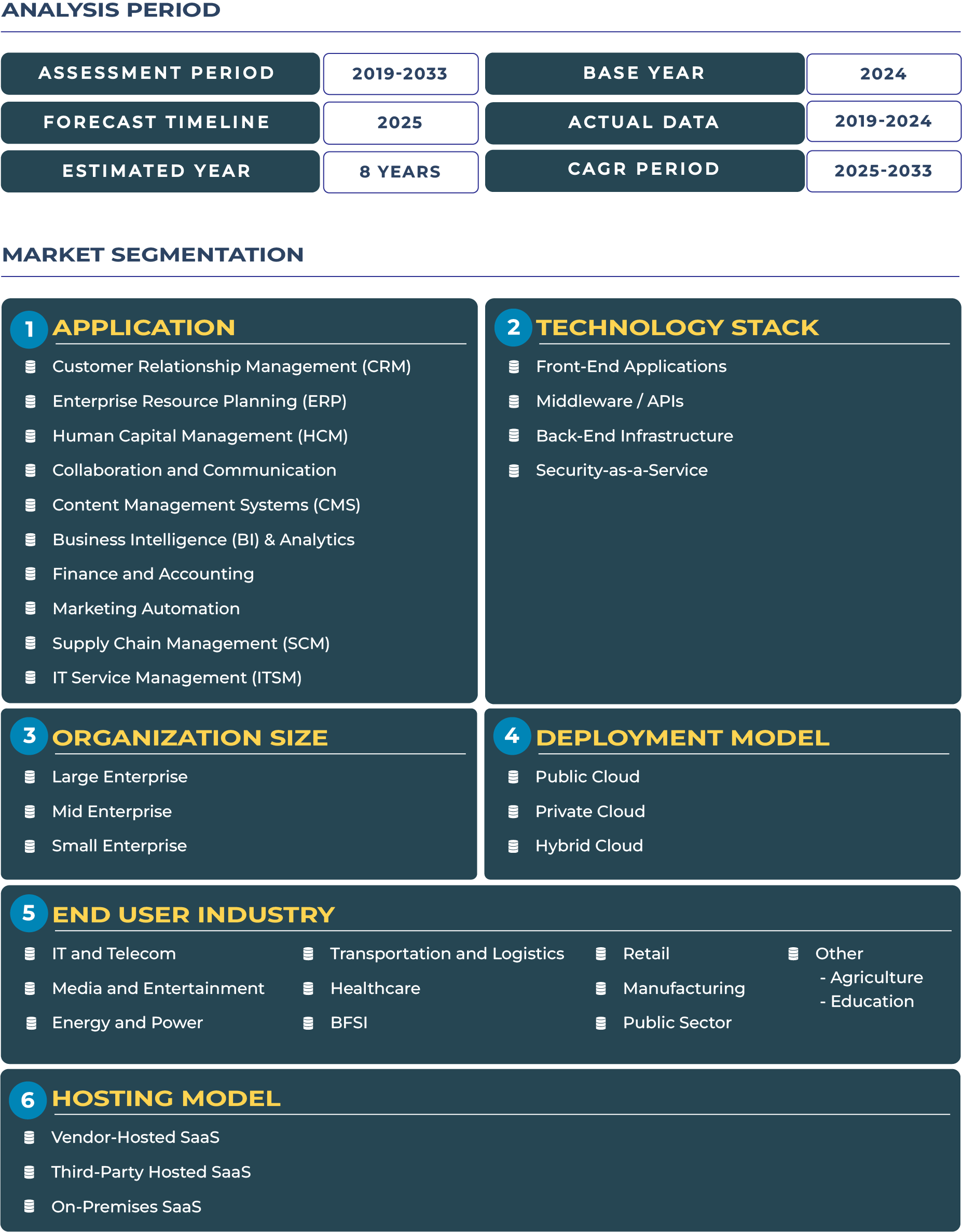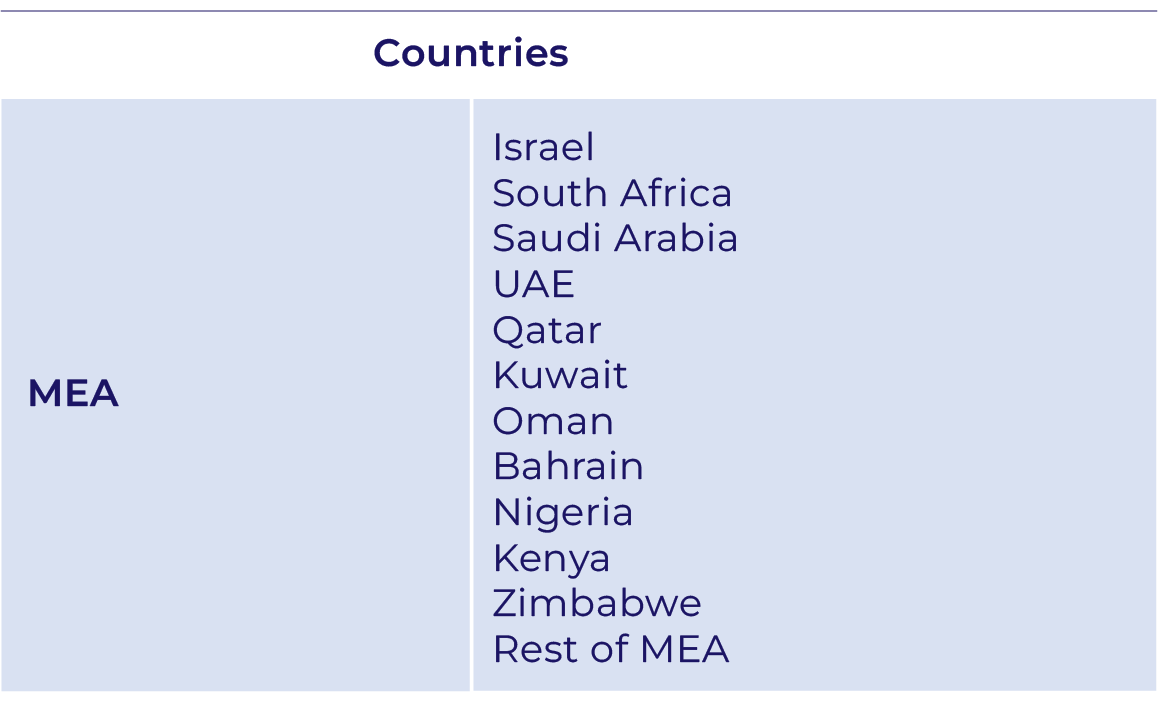Report Format:
![]()
![]() |
Pages: 160+
|
Pages: 160+
MEA SaaS Market Outlook
Dual-Speed SaaS Adoption Defines the Middle East and Africa Software as a Service Market Landscape
The Middle East and Africa (MEA) region represents a bifurcated Software as a Service market, where advanced economies like the Gulf Cooperation Council (GCC) states exhibit enterprise-grade SaaS maturity, while much of Sub-Saharan Africa remains in the early stages of digital transformation. As of 2024, the region reflects a unique divergence—on one end, GCC countries are deploying sophisticated ERP, CRM, and finance and accounting SaaS suites to digitize public and private enterprises; on the other, foundational cloud-based communication, CMS, and lightweight business intelligence tools are catalyzing small business inclusion in emerging African markets.
This duality has spurred a region-wide SaaS ecosystem that is both resilient and fast-evolving. As of 2025, the MEA Software as a Service market is estimated to grow at a CAGR of 13.1% between 2025 and 2033, reaching a total market size of USD 17.45 billion by 2033. The acceleration is driven by strategic public digitization roadmaps (especially in Saudi Arabia, UAE, Egypt, and Kenya), widespread fintech adoption, and cloud-first IT policies. While GCC countries demand robust, compliance-integrated SaaS platforms with localized APIs and modular deployment capabilities, African SaaS markets require mobile-first architecture, subscription-based pricing, and multilingual support to overcome infrastructure limitations.
Key Catalysts Accelerating SaaS Penetration Across Diverse Economies in MEA
The growth of the MEA software as a service sector is underpinned by a mix of investment, infrastructure modernization, and multi-cloud deployment capability. Gulf countries such as the UAE and Saudi Arabia have been instrumental in building the SaaS infrastructure, primarily through national cloud strategies (e.g., Saudi’s Vision 2030 and UAE’s Smart Government initiatives). These programs have enabled the digitization of public services and institutionalized SaaS across verticals like healthcare, banking, logistics, and education.
Moreover, the increasing availability of SaaS platforms on multiple cloud environments is strengthening vendor resilience and service continuity across fragmented jurisdictions. Large enterprises in GCC states are now favoring hybrid and multi-cloud SaaS environments to comply with local data residency mandates. On the African front, localized SaaS startups in Kenya, Nigeria, and Rwanda are drawing venture capital to deliver lightweight HCM and CRM solutions optimized for mobile.
Additionally, the COVID-19 pandemic underscored the necessity of remote collaboration tools and finance SaaS for business continuity. The subsequent economic rebound has furthered SaaS usage in retail, SME services, and logistics by enabling cost-efficient digital onboarding of clients and partners. These structural drivers collectively underscore a bullish outlook for the MEA SaaS industry through the next decade.
Structural Frictions Slowing Full-Scale SaaS Transformation in MEA
Despite growing SaaS acceptance, several inhibitors continue to restrict universal adoption across the MEA software as a service landscape. Regulatory compliance complexity—especially in cross-border operations—is a major friction point. Countries with overlapping jurisdictional data protection laws (e.g., Egypt, Morocco, and Saudi Arabia) lack regulatory harmonization, causing deployment delays and integration challenges for global SaaS vendors.
Infrastructure limitations, especially in Sub-Saharan Africa, pose additional risks. Internet penetration rates remain inconsistent, particularly in rural regions where connectivity is insufficient for uninterrupted SaaS usage. For instance, while South Africa and Kenya have robust digital infrastructure, countries like Chad or Sudan still struggle with basic connectivity and power stability.
Another challenge is the underutilization of offline functionality in most SaaS offerings, which affects platform reliability in regions with power outages or network congestion. Furthermore, the rising prevalence of SaaS-based e-learning and education platforms has placed additional stress on bandwidth and exposed gaps in cybersecurity readiness, limiting trust in enterprise-grade SaaS platforms in certain sub-segments.
Cloud-Native Innovation and Disaster Recovery SaaS Shape the Next-Gen Adoption Curve
One of the most influential trends in the MEA software as a service industry is the integration of DevOps pipelines and AI-generated code deployment within SaaS platforms. Particularly in digital-forward economies like the UAE, Bahrain, and Israel, DevSecOps-enabled SaaS systems are rapidly reducing development cycles and minimizing cybersecurity vulnerabilities. SaaS-based disaster recovery-as-a-service (DRaaS) offerings are also gaining traction among SMEs and public sector entities, especially in politically volatile geographies such as Ethiopia and Lebanon.
Subscription-based pricing models and modular SaaS applications continue to define go-to-market strategies across the MEA region. This model not only ensures affordability but also allows enterprises to scale SaaS adoption based on user demand and data sensitivity. Meanwhile, white-label SaaS offerings and API-driven custom platforms are opening up new monetization pathways for system integrators and ISVs in Egypt, Tunisia, and Nigeria.
As the region becomes more digitally interlinked, SaaS solutions offering cross-border compliance, digital tax filing, and automated reporting are expected to gain prominence. These functions are especially crucial in pan-African fintech operations, where regulatory fluidity necessitates scalable and customizable compliance frameworks.
Regulatory Modernization Drives Trust and Localization in SaaS Procurement
MEA’s SaaS expansion is increasingly shaped by proactive regulatory actions. GCC regulators, including the Communications and Information Technology Commission (CITC) in Saudi Arabia and the Telecommunications and Digital Government Regulatory Authority (TDRA) in the UAE, are driving cloud regulation modernization. These authorities have introduced clear mandates around data residency, encryption standards, and auditability, which incentivize enterprises to adopt compliant SaaS solutions.
In Africa, Rwanda’s Ministry of ICT and Innovation and Kenya’s ICT Authority are supporting cloud adoption through fiscal incentives and digital transformation grants. Several countries are also investing in government-to-citizen (G2C) SaaS portals for digital ID management, e-health records, and digital taxation. The regulatory clarity and government-backed procurement pipelines are key catalysts for deeper SaaS integration into mission-critical sectors.
Geopolitical and Economic Shifts Reshape Deployment and Vendor Strategy
The MEA software as a service market is also affected by broader macroeconomic and geopolitical conditions. Ongoing tensions in parts of the Middle East, such as Yemen and Syria, and socio-political unrest in North African countries, disrupt cloud infrastructure deployment timelines and elevate operational risks. Currency volatility in nations like Egypt and Nigeria also impacts SaaS pricing models, necessitating multi-currency billing and flexible subscription terms.
Nevertheless, international financial support from IMF and World Bank, especially in pandemic recovery programs, has improved national digital infrastructure in select African states. Additionally, pan-regional economic alliances—such as the African Continental Free Trade Area (AfCFTA)—are expected to standardize compliance, thereby enhancing SaaS market interoperability across Africa.
Competitive Landscape: Regional Startups and Global Giants Shape the MEA SaaS Race
The MEA software as a service sector is characterized by a diverse competitive landscape. International giants like Oracle, Salesforce, Microsoft, and SAP have expanded their regional cloud presence through local data centers in the UAE, Saudi Arabia, South Africa, and Egypt. In parallel, regional champions such as Saudi’s Takamol, Egypt’s Digital Egypt platform, and South Africa’s Yoco are scaling country-specific platforms for HCM, CRM, and financial SaaS.
Key strategies include cloud provider coverage expansion and compliance localization to accommodate data sovereignty laws. SaaS providers are also investing in partnerships with telecom providers and fintech platforms to expand last-mile delivery, especially in underserved African regions. For example, in 2024, Microsoft launched its Azure-based OpenAI services through regional partners in Africa and the Middle East to empower regional SaaS developers.
The MEA SaaS Market Requires Adaptive Monetization and Policy-Driven Expansion Models
The future of the MEA software as a service market hinges on adaptive monetization models, government-backed digital infrastructure, and vendor flexibility in deployment and compliance alignment. The region’s digital bifurcation—enterprise maturity in GCC states and bottom-up digitization in African economies—will require differentiated strategies from SaaS vendors and policymakers alike.
As multi-market strategies, localization, and mobile optimization grow more critical, stakeholders must recognize that no one-size-fits-all approach will work in the MEA region. The opportunity lies in tailoring SaaS offerings to match the infrastructural maturity, regulatory landscape, and digital readiness of each economy.








